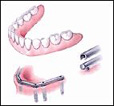Tooth
loss can have a far-reaching effect on
your dental health and personal appearance. When you lose one or more
teeth, your remaining teeth can drift out of position. This can lead to a
change in the bite, the loss of additional teeth, decay and gum
disease.
Dental
implants can be an effective method to
replace one tooth or several teeth. Each implant consists of a metal
anchor that is inserted into the jawbone, and a protruding post, which is
outfitted with an artificial tooth. Implants can also support a bridge,
replace a partial denture or secure a fixed denture. The process requires
surgery and may take up to a year to complete.
 |
 |
Replace a missing tooth |
| Support a bridge |
 |
 |
 |
 |
Secure a removable denture |
| Secure a fixed denture |
 |
 | |
|
PROCEDURES
Several steps
are usually necessary to place an implant. Depending on the type of
implant, the steps may vary. The placement of a single-tooth endosteal
implant is illustrated below:
 |
 |
The first step is
completed under local anesthesia. A metal anchor, or artificial root
is placed into the jawbone. Bone grows around the anchor. This takes
about three to six months. |
| Next, a "healing cap" is
placed when the implant is uncovered. |
 |
 |
 |
 |
Then, the healing cap is
removed and a metal post, or abutment, may be attached to the
anchor. |
| When your gums and jawbone
have healed, a crown (artificial tooth) is constructed, then screwed
or cemented to the post. Fitting your new crown properly may take
several appointments. |
 |
 | Brush and floss
your implant twice daily, just like your natural teeth. Be sure to brush
the back of the abutments and floss around the front, back and sides.
Avoid chewing on hard objects or extremely sticky food. Proper oral
hygiene will help keep your implants and your mouth
healthy.
Be sure to follow the
special home care instructions provided by your dental
professional.
|